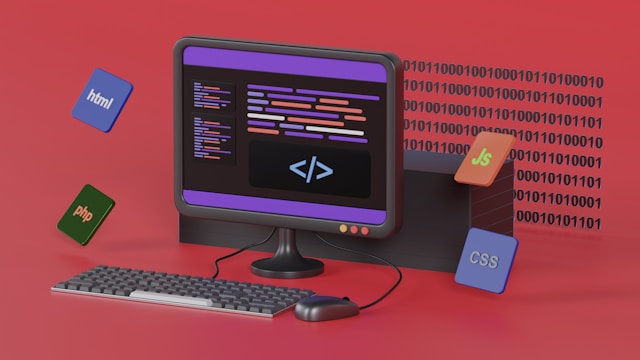Bachelor of Web Development
Learn how to tackle the latest build challenges facing the creative industries with a BA/BSC (Hons) web development degree from SAE.
Campuses
Belgrade
Duration(s)
6 Trimesters Full Time (Fast Track)
Complete your course faster by studying through 6 trimesters across 2 years.
Bachelor of Web Development
Course Durations
6 Trimesters Full Time (Fast Track)
Complete your course faster by studying through 6 trimesters across 2 years.
Start Date(s)
Belgrade
January and September
Bachelor of Web Development
Start Dates
Belgrade
January and September
Entry Requirements
Bachelor of Web Development
Domestic Entry Requirements
Both domestic and international students must meet one of the following criteria:
Completion of a Senior Secondary Certificate of Education (your Year 12 certificate) or equivalent; OR
at least 21 years old and demonstrated experience.
English language certificate (IELTS, TOEFL, any CEFR certificate) showing B2 level competence.
Bachelor of Web Development
International Entry Requirements
International Entry Requirements
Both domestic and international students must meet one of the following criteria:
Completion of a Senior Secondary Certificate of Education (your Year 12 certificate) or equivalent; OR
at least 21 years old and demonstrated experience.
English language certificate (IELTS, TOEFL, any CEFR certificate) showing B2 level competence.
Fees
Bachelor of Web Development
Domestic fees
Contact at belgrade@sae.edu
Bachelor of Web Development
International fees
Contact at belgrade@sae.edu
WHY THIS PROGRAMME
99% of our students find a job during their second year of studies or immediately after graduation, working with startups, digital agencies, or international tech companies.

What you'll learn:
At the end of your Web Development degree you will:
- Design and develop interactive web applications using coding languages such as HTML, CSS, JavaScript, Python and SQL.
- Learn to confidently use Adobe Creative Cloud programmes including Photoshop, Illustrator and Dreamweaver.
- Gain an understanding of back-end web development, exploring databases, SQL operations and content management systems.
- Collaborate with fellow students from other SAE disciplines on your web projects, such as game developers, animators, filmmakers and musicians.
- Apply theoretical knowledge to practical scenarios and develop an employment-ready portfolio.
- Enhance your problem-solving and teamwork skills.
- Build a network of connections across the creative industries – from peers to professionals.
- Graduate with a well-rounded web development degree from a recognised creative institute, ready to launch your career.

Possible career paths include
- Web Designer / Front-End Developer
- UX/UI Designer
- Full-Stack Developer
- Product Designer / Digital Product Creator
- App Developer
- Creative Technologist or Startup Founder
Course Structure
Stage 1: Foundations
Develop the essential technical design skills and the knowledge required to collaborate with other creative media students and professionals.
Design digital products from the ground up. Learn interface design with Figma, wireframing, accessibility, and UX research. Explore AI-assisted tools like Uizard, Midjourney, and
ChatGPT to rapidly prototype ideas and generate visual assets.
Collaborate like product teams do — across design and development.
ChatGPT to rapidly prototype ideas and generate visual assets.
Collaborate like product teams do — across design and development.
Master semantic HTML5, responsive CSS with Tailwind, and how the web actually works. Learn about DNS, hosting, HTTP, and how to launch a site live. Use Git and GitHub from the start. Explore Bash/Terminal basics for working efficiently withdev tools.
AI tools assist in layout, content, and accessibility checks.
AI tools assist in layout, content, and accessibility checks.
Code dynamic interfaces with modern JavaScript (ES6+). Learn how to manipulate the DOM, build components, consume APIs, and manage state.
Introduce basic data structures and control flow logic. AI coding assistants like Copilot or Cursor are used to accelerate learning, provide alternatives, and debug strategies.
Introduce basic data structures and control flow logic. AI coding assistants like Copilot or Cursor are used to accelerate learning, provide alternatives, and debug strategies.
Understand how data flows on the web. Build RESTful APIs with MVC structure, manage users and sessions, connect to SQL databases, and implement secure auth. Learn backend using Laravel (PHP) and compare structure and performance with Node.js + Nest.js. Focus is on reusable architecture and security.
Stage 2: Advanced - Refine & Expand
Broaden your scope to work on complex multidisciplinary projects in accordance with industry standard practices.
Work in teams to build full-stack applications using Vue, React, and Laravel APIs. Learn to integrate frontends with backends via JSON APIs. Compare monolithic vs service-based architecture. Use GitHub Projects, Agile sprints, and collaboration tools. Set up CI/CD pipelines, use Docker, and deploy to the cloud.
AI tools support code generation, component scaffolding, and testing.
AI tools support code generation, component scaffolding, and testing.
Learn how to turn ideas into scalable, fundable, and sustainable products. Explore startup strategy, monetization models, business planning, and go-to-market execution. Address how AI is transforming the economics of tech businesses.
Build academic and career skills through structured research, professional writing, and technical documentation. Learn how to present your work, build a professional profile, and navigate the ethical and strategic challenges of a tech career in the age of AI.
Dive deeper into a technology or concept of your choice. Projects often involve AI, IoT, Web3, or interactive media. Scope, design, and implement an advanced system — e.g., AI-enhanced chatbot, IoT dashboard, or Web3-based platform.
Supported by research and mentorship.
Supported by research and mentorship.
Stage 3: Showcase
Execute a project of your own design which is of high quality and externally published, with the knowledge to commercialise if you choose. You'll also apply your skills through industry work placement.
Build and launch your own production-ready software product. Integrate AI, APIs, monitoring, testing, and business logic. Deliver working code, deployment pipelines, and technical documentation. Present to peers, faculty, and industry professionals.
UCAS Course Codes
BA/BSc (Hons) Web Development
6 TRIMESTERS

Easy transition into postgraduate courses
SAE Bachelor Degrees are structured in an integrated course framework.
This means that when you complete an SAE of Design & Visual Communication you will be awarded the maximum credit points available, providing you with the opportunity to seamlessly transition into the higher-level postgraduate qualifications if you choose to do so.



























